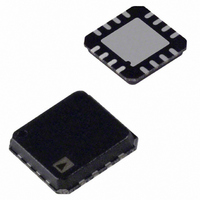ADA4950-1YCPZ-R2 Analog Devices Inc, ADA4950-1YCPZ-R2 Datasheet - Page 20

ADA4950-1YCPZ-R2
Manufacturer Part Number
ADA4950-1YCPZ-R2
Description
Fixed Gain 1,2&3 Diff ADC Driver
Manufacturer
Analog Devices Inc
Type
Differential Amplifierr
Datasheet
1.ADA4950-1YCPZ-R7.pdf
(28 pages)
Specifications of ADA4950-1YCPZ-R2
Amplifier Type
Differential
Number Of Circuits
1
Output Type
Differential
Slew Rate
2900 V/µs
-3db Bandwidth
750MHz
Voltage - Input Offset
200µV
Current - Supply
9.5mA
Current - Output / Channel
114mA
Voltage - Supply, Single/dual (±)
3 V ~ 11 V, ±1.5 V ~ 5.5 V
Operating Temperature
-40°C ~ 105°C
Mounting Type
Surface Mount
Package / Case
16-LFCSP
No. Of Amplifiers
1
Input Offset Voltage
2.5mV
Bandwidth
750MHz
Supply Voltage Range
3V To 11V
Supply Current
9.5mA
Amplifier Case Style
LFCSP
No. Of Pins
16
Rohs Compliant
Yes
Number Of Channels
1
Number Of Elements
1
Power Supply Requirement
Single/Dual
Common Mode Rejection Ratio
49dB
Voltage Gain Db
66dB
Single Supply Voltage (typ)
5/9V
Dual Supply Voltage (typ)
±3/±5V
Power Supply Rejection Ratio
84dB
Rail/rail I/o Type
No
Single Supply Voltage (min)
3V
Single Supply Voltage (max)
11V
Dual Supply Voltage (min)
±1.5V
Dual Supply Voltage (max)
±5.5V
Operating Temp Range
-40C to 105C
Operating Temperature Classification
Industrial
Mounting
Surface Mount
Pin Count
16
Package Type
LFCSP EP
Lead Free Status / RoHS Status
Lead free / RoHS Compliant
Gain Bandwidth Product
-
Current - Input Bias
-
Lead Free Status / Rohs Status
Compliant
ADA4950-1/ADA4950-2
Table 12. Differential Input, DC-Coupled
Nominal Linear Gain
1
2
3
Table 13. Single-Ended, Ground-Referenced Input, DC-Coupled, R
Nominal Linear Gain
1
2
3
1
Similar to the case of a conventional op amp, the output noise
voltage densities can be estimated by multiplying the input-
referred terms at +INx and −INx by the appropriate output
factor, where:
When the feedback factors are matched, R
β1 = β2 = β, and the noise gain becomes
Note that the output noise from V
total differential output noise density, v
square of the individual output noise terms.
Table 12 and Table 13 list the three available gain settings,
associated resistor values, input impedance, and output noise
density for both balanced and unbalanced input configurations.
CALCULATING THE INPUT IMPEDANCE FOR AN
APPLICATION CIRCUIT
The effective input impedance of a circuit depends on whether
the amplifier is being driven by a single-ended or differential
signal source. For balanced differential input signals, as shown
in Figure 54, the input impedance (R
The value of R
G
β
R
1
G2
N
=
= R
=
R
G
v
R
IN, dm
nOD
G1
(
F1
N
β
R
+ (R
1
=
+
G1
+
=
2
R
= (R
1
β
S
||R
β
G1
=
2
∑
i
T
8
=
G
).
)
1
1
G
and
v
depends on the selected gain.
+
is the circuit noise gain.
+ R
nOi
2
R
R
G
F
G
β
) = 2 × R
2
=
R
F2
R
+
R
500
500
500
G2
R
500
500
500
G
F
R
F
(Ω)
G2
(Ω)
OCM
are the feedback factors.
IN, dm
goes to 0 in this case. The
nOD
R
500
250
250||500 61.9
) is
G1
, is the root-sum-
F1
/R
(Ω)
G1
= R
R
53.6
57.6
R
500
250
250||500
F2
T
G
(Ω) (Std 1%) R
/R
(Ω)
G2
,
Rev. 0 | Page 20 of 28
667
375
267
R
1000
500
333
IN, se
IN, dm
S
= 50 Ω
(Ω)
For an unbalanced, single-ended input signal (see Figure 55),
the input impedance is
The input impedance of the circuit is effectively higher than it
is for a conventional op amp connected as an inverter because a
fraction of the differential output voltage appears at the inputs
as a common-mode signal, partially bootstrapping the voltage
across the input resistor, R
amplifier input terminals can be easily determined by noting
that the voltage at the inverting input is equal to the noninverting
output voltage divided down by the voltage divider that is formed
by R
input terminals due to negative voltage feedback and is in phase
with the input signal, thus reducing the effective voltage across
R
(Ω)
G
in the upper loop and partially bootstrapping R
Figure 54. ADA4950-x Configured for Balanced (Differential) Inputs
F
R
and R
IN
Figure 55. ADA4950-x with Unbalanced (Single-Ended) Input
R
526
277
194
Differential Output Noise Density (nV/√Hz)
9.25
12.9
16.6
,
R
G2
se
IN, se
(Ω)
=
G
V
IN, dm
in the lower loop. This voltage is present at both
⎛
⎜
⎜
⎜
⎜
⎝
1
1
−
V
R
R
OCM
G
G
R
R
2
Differential Output Noise Density (nV/√Hz)
9.07
12.2
15.0
G
G
×
(
R
V
R
G
OCM
R
G
+IN
–IN
F
ADA4950-x
+
G
. The common-mode voltage at the
R
R
R
ADA4950-x
F
F
+V
–V
F
+V
–V
R
R
)
S
S
F
S
S
F
⎞
⎟
⎟
⎟
⎟
⎠
R
L
V
V
OUT, dm
OUT, dm
G
.















